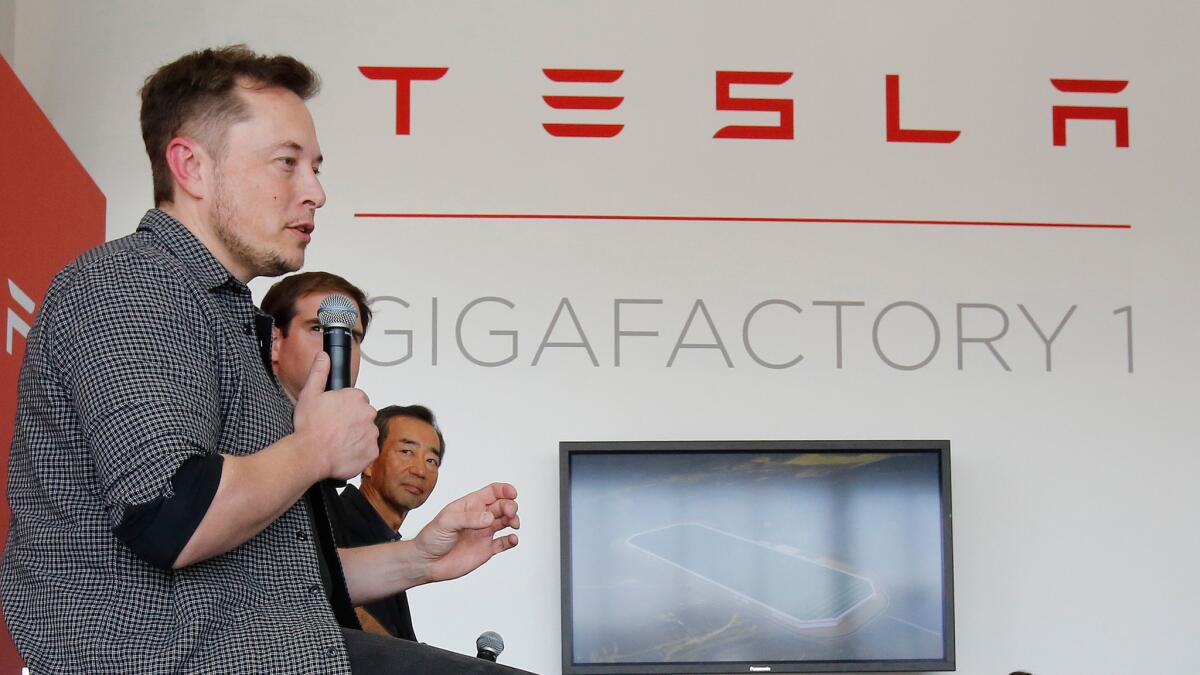Elon Musk tests Wall Street’s appetite for unprofitable cash-burning ventures

- Share via
With his latest move, Elon Musk is challenging Wall Street to determine whether merging two of his high-flying but unprofitable companies will help bolster their performance or double their risk.
How investors decide the issue is crucial to the future of a combined Tesla and SolarCity because they’ll need to continue tapping the financial markets to satisfy their voracious appetite for funds.
Electric automaker Tesla Motors Inc. agreed Monday to acquire solar-power provider SolarCity Corp. for $2.6 billion in Tesla stock. Musk is the largest shareholder and chairman of both firms.
The billionaire sees the companies’ marriage as a way to gain efficiencies for both operations, part of his “master plan” to combine solar power and its storage — such as for Tesla car batteries — into a single “sustainable energy company.”
“We expect to achieve cost synergies of $150 million in the first full year after closing” the merger, Tesla said in a blog post Monday.
“We also expect to save customers money by lowering hardware costs, reducing installation costs, improving our manufacturing efficiency and reducing our customer-acquisition costs,” Tesla said.
But both Tesla and SolarCity have been losing money and burning through lots of cash as they attempt to expand their operations. Both rely on government subsidies, which won’t last forever. Those factors have some analysts fretting that fusing the firms makes their financial situation more precarious.
“We see benefits from a combined solar/storage offering and manufacturing efficiencies, but remain concerned about cash flow and capital needs,” analyst Efraim Levy of S&P Global Market Intelligence said in a note to clients Monday.
Tesla lost $888.7 million on revenue of $4.05 billion in 2015, a year in which it delivered 50,580 vehicles, mostly its mainstay Model S sedan.
Tesla, based in Palo Alto, also builds the Model X sport utility vehicle and is ramping up production for its $35,000 mass-market sedan, the Model 3, with deliveries set to start late next year.
So far, Wall Street has been willing to keep supporting Musk’s companies with fresh capital, a need that is expected to grow as Tesla and SolarCity tackle bigger pieces of Musk’s master plan.
Tesla had $1.44 billion of cash as of March 31, down from nearly $2 billion at the end of 2014. But in May, the company raised an additional $1.7 billion with a secondary stock offering; it’s a familiar pattern in which Tesla has issued stock or convertible debt every year since it went public in June 2010.
SolarCity, meanwhile, lost $768.8 million last year on revenue of $399.6 million, and its cash on the balance sheet shrank to $361.7 million as of March 31 from $504.4 million at the end of 2014. It also had more than $1 billion of long-term debt.
But SolarCity said in July that it raised an additional $345 million from four partners to fund the equipment and installation of new solar projects.
In a separate statement updating its 2016 operations, SolarCity said Monday that “residential bookings in the first half of the year were still lower than we anticipated” despite fresh efforts to boost sales.
The statement “reaffirms weak market trends,” analyst Patrick Jobin of Credit Suisse said in a research note.
SolarCity also is facing regulatory pressure in certain states such as Nevada and Arizona, which is one reason that its stock price has plunged by more than half so far this year.
In December, for instance, SolarCity announced that it would cease operations in Nevada after regulators drastically cut benefits to rooftop solar owners.
Utility companies argue that rooftop solar owners do not pay their fair share of the cost for the poles, wires and substations that make up the electric grid.
Utilities have pressed regulators in states nationwide to increase fees on rooftop solar owners and to cut the amount paid for electricity that those solar owners produce. That could curb demand for SolarCity’s products.
SolarCity’s shares fell $1.98, or 7.4%, to $24.72 on Monday. Tesla’s stock fell $4.78, or 2%, to $230.01.
Their proposed merger calls for SolarCity holders to receive 0.11 of a Tesla share for each SolarCity share, or $25.30 a share based on Tesla’s close Monday.
When the companies first disclosed their deal in June, they indicated a price between $26.50 and $28.50 of Tesla stock per SolarCity share.
Musk on Monday assured investors that the companies’ rapid cash consumption was more a sign of success than anything else.
“If we weren’t in such a kind of crazy rapid growth mode,” he told analysts during a conference call, “we would be producing significant free positive cash flow.”
For more business news, follow James F. Peltz on Twitter: @PeltzLATimes
MORE FROM BUSINESS
Why U.S. tech companies can’t figure out China
Ionis shares leap 30% after a drug trial goes so well, it ends early
Photographer sues Getty Images for $1 billion after she’s billed for her own photo
More to Read
Inside the business of entertainment
The Wide Shot brings you news, analysis and insights on everything from streaming wars to production — and what it all means for the future.
You may occasionally receive promotional content from the Los Angeles Times.











